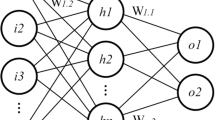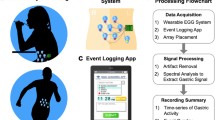Abstract
Obesity is one of leading risk factors for type 2 diabetes and other types of chronic diseases. Synchronized intestinal electrical stimulation (SIES) has been explored for treating obesity and diabetes. In SIES, electrical stimulation is delivered to the small intestine in synchronization with the intrinsic intestinal myoelectrical activity (its basic rhythm is called slow wave) and therefore, the accurate detection of intestinal slow waves is critically important for SIES. The aim of this study is to detect the peaks in intestinal slow waves in real-time based on the automatic multiscale peak detection (AMPD) method. In this paper, we introduce an efficient technique for real-time detection of peaks in intestinal slow waves. The presented method is based on peak estimation of a given quasi-periodic signal using the AMPD method. This method uses a multi-scale approach to identify the peaks of the intestinal slow waves with high detection accuracy and a minimal delay. Throughout the experiments, the multi-scale technique is used to estimate the quasi-periodic signals using different signal-to-noise ratio, λ (optimal scale), and the “lag” β (number of datapoints for right hand estimation) as important performance factors. The performance of the presented method is also calculated and utilized in the comparison process for 10 datasets of the intestinal slow waves from rats at λ = 150 ms and two values of β = 100 ms and 150 ms. The experimental results show that the presented method has good overall accuracy for online peak detection while maintaining low memory and computational complexity. Numerically, the overall accuracy is above 90%, and 98% for the rodent intestinal slow waves at a time-lag of 150 ms. The developed SIES system has been applied to successfully reduce postprandial blood glucose in a rodent model of hyperglycemia. In conclusion, the developed algorithm is adequate for on-line peak detection of the intestinal slow waves; the SIES method used the developed peak detection algorithm which is effective in reducing postprandial blood glucose in a rodent model of hyperglycemia.
Graphical Abstract








Similar content being viewed by others
References
Purnell JQ (2000) Definitions, classification, and epidemiology of obesity. MDText.com, Inc
Hruby A. Hu FB (2015) The epidemiology of obesity: a big picture. PharmacoEcon 33(7). Springer International Publishing 673–689. https://doi.org/10.1007/s40273-014-0243-x
Magkos F, Yannakoulia M, Chan JL, Mantzoros CS (2009) Management of the metabolic syndrome and type 2 diabetes through lifestyle modification. Annu Rev Nutr 29:223–256. https://doi.org/10.1146/annurev-nutr-080508-141200
Weir MA et al (2011) Orlistat and acute kidney injury: an analysis of 953 patients”. Arch Intern Med 171(7):703–704. https://doi.org/10.1001/archinternmed.2011.103
Vetter ML, Ritter S, Wadden TA, Sarwer DB (2012) Comparison of bariatric surgical procedures for diabetes remission: efficacy and mechanisms. Diabetes Spectrum 25(4):200–210. https://doi.org/10.2337/diaspect.25.4.200
Beckman LM et al (2011) Changes in gastrointestinal hormones and leptin after Roux-en-Y gastric bypass surgery. J Parenter Enter Nutr 35(2):169–180. https://doi.org/10.1177/0148607110381403
Kheirvari M et al (2020) The advantages and disadvantages of sleeve gastrectomy; clinical laboratory to bedside review. Heliyon 6(2). Elsevier Ltd. https://doi.org/10.1016/j.heliyon.2020.e03496
Ouyang X, Li S, Tan Y, Lin L, Yin J, Chen JDZ (2019) Intestinal electrical stimulation attenuates hyperglycemia and prevents loss of pancreatic β cells in type 2 diabetic Goto-Kakizaki rats. Nutr Diabetes 9(1):4. https://doi.org/10.1038/s41387-019-0072-2
Sun Y, Song GQ, Yin J, Lei Y, Chen JDZ (2009) Effects and mechanisms of gastrointestinal electrical stimulation on slow waves: a systematic canine study. Am J Physiol-Regul Integr Comp Physiol 297(5).https://doi.org/10.1152/ajpregu.00006.2009
Yin J, Chen JD (2010) Mechanisms and potential applications of intestinal electrical stimulation. Dig Dis Sci 55(5):1208–1220
Dong Y, Yin J, Zhang Y, Chen JD (2021) Electronic bypass for diabetes: optimization of stimulation parameters and mechanisms of glucagon‐like peptide‐1. Neuromodulation: Technol Neural Interface
Du P, Li S, O’Grady G, Cheng LK, Pullan AJ, Chen JD (2009) Effects of electrical stimulation on isolated rodent gastric smooth muscle cells evaluated via a joint computational simulation and experimental approach. Am J Physiol Gastrointest Liver Physiol. 297(4):G672-80. https://doi.org/10.1152/ajpgi.00149.2009
Liu J, Xiang Y, Qiao X, Dai Y, Chen JD (2011) Hypoglycemic effects of intraluminal intestinal electrical stimulation in healthy volunteers. Obes Surg 21(2):224–230
Liu S, Hou X, Chen JD (2005) Therapeutic potential of duodenal electrical stimulation for obesity: acute effects on gastric emptying and water intake. Off J Am Coll Gastroenterol| ACG 100(4):792–6
Wan X, Yin J, Foreman R, Chen JD (2017) An optimized IES method and its inhibitory effects and mechanisms on food intake and body weight in diet-induced obese rats: IES for obesity. Obes Surg 27(12):3215–3222
Yin J, Chen JD (2007) Excitatory effects of synchronized intestinal electrical stimulation on small intestinal motility in dogs. Am J Physiol Liver Physiol 293(6):G1190–G1195. https://doi.org/10.1152/ajpgi.00092.2007
Jacobson ML (2001) Auto-threshold peak detection in physiological signals. Annu Rep Res React Inst, Kyoto Univ 3:2194–2195. https://doi.org/10.1109/iembs.2001.1017206
Pan J, Tompkins WJ (1985) A real-time QRS detection algorithm. IEEE Trans Biomed Eng BME-32(3):230–236. https://doi.org/10.1109/TBME.1985.325532
Du P, Kibbe WA, Lin SM (2006) Improved peak detection in mass spectrum by incorporating continuous wavelet transform-based pattern matching. Bioinformatics 22(17):2059–2065. https://doi.org/10.1093/bioinformatics/btl355
Benitez D, Gaydecki PA, Zaidi A, Fitzpatrick AP (2001) The use of the Hilbert transform in ECG signal analysis. Comput Biol Med 31(5):399–406. https://doi.org/10.1016/S0010-4825(01)00009-9
Mehta SS, Shete DA, Lingayat NS, Chouhan VS (2010) K-means algorithm for the detection and delineation of QRS-complexes in electrocardiogram. IRBM 31(1):48–54. https://doi.org/10.1016/j.irbm.2009.10.001
Xue Q, Hu YH, Tompkins WJ (1992) Neural-network-based adaptive matched filtering for QRS detection. IEEE Trans Biomed Eng 39(4):317–329. https://doi.org/10.1109/10.126604
Vijaya G, Kumar V, Verma HK (1998) ANN-based QRS-complex analysis of ECG. J Med Eng Technol 22(4):160–167. https://doi.org/10.3109/03091909809032534
Scholkmann F, Boss J, Wolf M (2012) An efficient algorithm for automatic peak detection in noisy periodic and quasi-periodic signals. Algorithms 5(4):588–603. https://doi.org/10.3390/a5040588
Panoulas KI, Hadjileontiadis LJ, Pasa SM (2001) Enhancement of R-wave detection in ECG data analysis using higher-order statistics. In Proceedings of the 23rd Annual International Conference of the IEEE, Thessaloniki, Greece 1:344–347
Mehta SS, Sheta DA, Lingayat NS, Chouhan VS (2010) K-Means algorithm for the detection and delineation of QRS-complexes in electrocardiogram. IRBM 31:48–54
Sharma S, Mehta SS, Mehta H (2011) Development of derivative based algorithm for the detection of QRS-complexes in single lead electrocardiogram using FCM. IJCA 4:19–23
Slimane Z-EH, Nait-Ali A (2010) QRS complex detection using empirical mode decomposition. Digit Signal Proc 20:1221–1228
Coast DA, Stern RM, Cano GG, Briller SA (1990) An approach to cardiac arrhythmia analysis using hidden Markov models. IEEE Trans Biomed Eng 37:826–836
Palshikar G (2009) Simple algorithms for peak detection in time-series. In Proceedings of 1st IIMA International Conference on Advanced Data Analysis, Business Analytics and Intelligence, Ahmedabad, India
Harmer K, Howells G, Sheng W, Fairhurst M, Deravi F (2008) A peak-trough detection algorithm based on momentum. In Proceedings of the International Congress on Image and Signal Processing CISP ’08, Sanya, Hainan, China 4:454–458
Sezan MI (1990) A peak detection algorithm and its application to histogram-based image data reduction. Comput Vis Graph Image Proc 49:36–51
Deng H, Xiang B, Liao X, Xie S (2006) A linear modulation-based stochastic resonance algorithm applied to the detection of weak chromatographic peaks. Anal Bioanal Chem 386:2199–2205
Solanki SK (2003) Sunspots: An overview. Astron Astrophys Rev 11:153–286
Mansouri C, Kashou NH (2012) New window on optical brain imaging; medical development, simulations and applications. In Selected Topics on Optical Fiber Technology; Yasin, M., Harun, S.W., Arof, H., Eds.; InTech: Rijeka, Croatia, 271–288
Ferrari M, Quaresima V (2012) A brief review on the history of human functional near-infrared spectroscopy (fNIRS) development and fields of application. Neuroimage 63:921–935
Morren G, Wolf M, Lemmerling P, Wolf U, Choi JH, Gratton E, De Lathauwer L, Van Huffel S (2004) Detection of fast neuronal signals in the motor cortex from functional near infrared spectroscopy measurements using independent component analysis. Med Biol Eng Comput 42:92–99
Steinbrink J, Kempf FCD, Villringer A, Obrig H (2005) The fast optical signal—robust or elusive when non-invasively measured in the human adult? Neuroimage 26:996–1008
Trajkovic I, Scholkmann F, Wolf M (2011) Estimating and validating the interbeat intervals of the heart using near-infrared spectroscopy on the human forehead. J Biomed Opt. https://doi.org/10.1117/1.3606560
Haensse D, Szabo P, Brown D, Fauchere JC, Niederer P, Bucher HU, Wolf M (2005) A new multichannel near-infrared spectro-photometry system for functional studies of the brain of adults and neonates. Opt Express 13:4525–4538
Porta A, Baselli G, Lombardi F, Cerutti S, Antolini R, Del Greco M, Ravelli F, Nollo G (1998) Performance assessment of standard algorithms for dynamic R-T interval measurement: comparison between R-Tapex and R-T(end) approach. Med Biol Eng Compu 36(1):35–42
Baumert M, Starc V, Porta A (2012) Conventional QT variability measurement vs. template matching techniques: comparison of performance using simulated and real ECG. PloS One 7(7):e41920. https://doi.org/10.1371/journal.pone.0041920
Azar T, Sharp J, Lawson D (2011) Heart rates of male and female Sprague-Dawley and spontaneously hypertensive rats housed singly or in groups. J Am Assoc Lab Anim Sci: JAALAS 50(2):175–184
Mautz WJ, Bufalino C (1989) Breathing pattern and metabolic rate responses of rats exposed to ozone. Respir Physiol 76(1):69–77. https://doi.org/10.1016/0034-5687(89)90018-2
Funding
This work was partially supported by grants from National Institutes of Health (R42DK100212 and R01DK107754).
Author information
Authors and Affiliations
Corresponding author
Ethics declarations
Conflict of interest
The authors declare no competing interests.
Additional information
Publisher's note
Springer Nature remains neutral with regard to jurisdictional claims in published maps and institutional affiliations.
Rights and permissions
Springer Nature or its licensor (e.g. a society or other partner) holds exclusive rights to this article under a publishing agreement with the author(s) or other rightsholder(s); author self-archiving of the accepted manuscript version of this article is solely governed by the terms of such publishing agreement and applicable law.
About this article
Cite this article
Moussalli, P., Li, S., Geweid, G.G.N. et al. An efficient online peak detection algorithm for synchronized intestinal electrical stimulation and its application for treating diabetes. Med Biol Eng Comput 61, 2317–2327 (2023). https://doi.org/10.1007/s11517-023-02832-z
Received:
Accepted:
Published:
Issue Date:
DOI: https://doi.org/10.1007/s11517-023-02832-z




